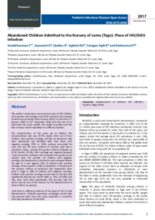Abstract
The authors conducted a case-control study of 102 children with positive HIV serology out of 956 received and screened at admission at Sainte Claire Nursery (SCN) in Lomé from 1st January 2000 to 31st December 2014 with the aim of to determine the social profile, the weight evolution and the fate of these children admitted in a difficult situation.
The characteristics of this study are as follows: the seroprevalence rate was 10.7%; nearly three out of four children with positive serology (76.5%) on admission had been abandoned and admitted later than those with negative serology (79% vs. 57%); orphans accounted for only 17% and 5% were children of mothers who had a psychiatric illness. Among HIV-positive children followed up to 18 months (73.5%), their serology was negative between 7 and 14 months. Nineteen (19) remained HIV positive at 18 months were HIV positive. All children with negative serology and abandoned on admission were adopted before the age of 1 year against 25% of children with positive serology. Three-quarters (75%) of adoptions in the group of HIV positive children at admission and abandoned were done in Togo vs. 40% of children with negative serology. Children with positive serology arrived late at the SCN and significantly beyond one month (43% vs. 21%, p<0.001) and they were more often abandoned. This assumes that HIV status may be one of the reasons for the abandonment of these children by parents.
Until there is sufficient evidence of the place of HIV in child abandonment, HIV/AIDS awareness campaigns should take into account data from this study especially in countries with high prevalence of HIV/AIDS.

